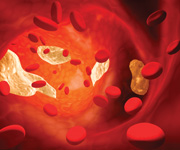Carnosine: A Proven Longevity Factor
 Mounting evidence documents the ability of carnosine to prevent many of the detrimental effects of aging.1
Mounting evidence documents the ability of carnosine to prevent many of the detrimental effects of aging.1
In our youth, carnosine shields us from the onslaught of oxidation, glycation, DNA damage, and other reactions that injure tissues and cripple organs.1
The problem is that as we grow older, carnosine levels in the body decline,2-4 leaving us vulnerable to loss of cognitive function, decreased mobility, loss of metabolic control, failing cardiovascular performance, and an increased susceptibility to cancer.
In laboratory animals of different species, carnosine supplementation extends life spans. This is all adding up to a new era in the way conventional medicine thinks about aging.
Scientists Explore Carnosine’s Longevity Benefits
Carnosine is found throughout the body wherever there are high energy demands such as in the brain, the heart, and our muscles.5 Its function is to protect these vital areas from the metabolic demands of energy production and management.6,7
Young organisms have high levels of carnosine in those energy-demanding tissues. As part of the aging process, carnosine levels decline over time.2-4 That’s because our bodies both make less carnosine as we age, and also because the carnosine we have is increasingly vulnerable to destruction. In human conditions such as diabetes and metabolic syndrome, which produce unnaturally accelerated aging, carnosine production is decreased, and its destruction is increased.8,9
 These findings suggest that a “carnosine deficiency” might be partly responsible for the visible aging and loss of function in a multitude of areas throughout the body that occurs as we get older.
These findings suggest that a “carnosine deficiency” might be partly responsible for the visible aging and loss of function in a multitude of areas throughout the body that occurs as we get older.
If we could restore our bodies’ carnosine stores to their youthful levels, we might be able to arrest part of the aging process.
Here are a few of the most dramatic observations in recent years that demonstrate how carnosine supplementation extends life spans:
- Carnosine slows the aging of human cells in culture dishes.10,11 Scientists added carnosine to cultures of young cells. While the control cells developed the typical “old” appearance, those grown in high carnosine concentrations retained their youthful appearance.5 When these youthful-appearing cells were transferred to culture dishes lacking extra carnosine, they quickly developed the “old” appearance of control cells of the same age. Yet, when scientists took old cells, approaching the limits of their life span, and transferred them into culture dishes containing high carnosine concentrations, they found that the cells rapidly became rejuvenated to resemble young cells.10
- Carnosine extends the life span of rotifers, a microscopic aquatic organism now being used as a model of aging in many laboratories.12 In this experiment, scientists tested many different antioxidant compounds, identifying carnosine as one of just four that had significant effects on the organisms’ longevity.
- Carnosine extends the life span of fruit flies, another organism commonly used to study aging, up to 20% in males.13,14 Normally, male fruit flies die much sooner than do females, but when fed a steady diet including a carnosine supplement, the males attained the same age as the females.
- Carnosine extends the life span of laboratory mice, complex, warm-blooded mammals with many of the aging features common to humans.15,16
Scientists used a strain of mice in which aging is markedly accelerated and supplemented their food with carnosine. Not only did the animals live significantly longer, they retained the physical and behavioral features of youthful animals.15 Next, the scientists tested the supplement in normal mice, finding much the same effects. Carnosine clearly improved the animals’ external appearances and maintained the animals in better condition than control animals receiving no carnosine.16
- Carnosine is a natural anti-aging constituent in your body.
- Carnosine fights such age-inducing processes as oxidation, glycation, protein cross-linking, mitochondrial dysfunction, telomere shortening,64 and transition metal accumulation.

- Carnosine levels decline with age, leaving you with progressively weaker defenses against age-related processes.
- Carnosine supplementation can restore youthful carnosine levels in blood and tissues, and it extends the life spans of experimental animals of many species.
- Carnosine supplementation may protect against neurodegenerative diseases and stroke; it also enhances exercise performance and comfort, ameliorates diabetes and its complications, and protects heart muscle and blood vessels from atherosclerosis.
Carnosine Protects Against Cardiovascular Disease
 Carnosine’s multi-targeted effects are most prominent in the heart and blood vessels. Carnosine has been shown to decrease mortality from strokes as well as mitigate the damaging effects of stroke on the brain itself.17-19 Studies in experimental animals show that carnosine, administered before or after a stroke is induced, protects brain cells from the so-called ischemia-reperfusion injury that occurs when tissue is first deprived of oxygen and is then subjected to high oxygen levels when blood flow is restored.17,18 That results in marked reduction in signs of oxidant damage to brain cells, and to a real and significant reduction in the size of the stroke area in the brain.18
Carnosine’s multi-targeted effects are most prominent in the heart and blood vessels. Carnosine has been shown to decrease mortality from strokes as well as mitigate the damaging effects of stroke on the brain itself.17-19 Studies in experimental animals show that carnosine, administered before or after a stroke is induced, protects brain cells from the so-called ischemia-reperfusion injury that occurs when tissue is first deprived of oxygen and is then subjected to high oxygen levels when blood flow is restored.17,18 That results in marked reduction in signs of oxidant damage to brain cells, and to a real and significant reduction in the size of the stroke area in the brain.18
Carnosine also protects heart muscle from ischemia (lack of blood flow), which can ultimately produce a heart attack. This protection derives from carnosine’s antioxidant actions, combined with its ability to trap oxidation-inducing transition metals, its acid-buffering capacity, and its influence on inflammatory cell activity.19 In fact, carnosine has been added to solutions used to protect heart muscle during open-heart surgery, when the heart is intentionally stopped, and there is high risk for ischemic damage.20
Carnosine’s actions on blood vessels may even prevent ischemia from occurring in the first place. Carnosine protects artery-lining endothelial cells from oxidation and glycation, both of which are early events in development of atherosclerosis.21,22 Studies show that carnosine prevents formation of dangerous “foam cells,” fat-laden scavenger cells that trigger the inflammatory response that produces deadly arterial plaque.23
Excessive muscle tone in arteries raises blood pressure and reduces blood flow to heart muscle and brain cells; carnosine reduces arterial tone by multiple mechanisms.24 It modulates calcium ion signaling in the smooth muscle cells that control vascular tone and enhances production of beneficial endothelial nitric oxide synthetase (eNOS) that induces arteries to relax.25
Given carnosine’s beneficial impact on skeletal muscle and exercise performance, it is hardly surprising to learn that carnosine also enhances heart muscle contractility. This is again a multifactorial effect, produced in part by carnosine’s ability to control calcium flow, and partly by its antioxidant, acid buffering, and anti-glycation activities.19,26,27
Carnosine Fights Diabetes and Its Consequences
 The global obesity epidemic brings with it the growing threat of type 2 diabetes and all of its devastating consequences that include cardiovascular disease, kidney failure, nerve damage, and eye disorders.
The global obesity epidemic brings with it the growing threat of type 2 diabetes and all of its devastating consequences that include cardiovascular disease, kidney failure, nerve damage, and eye disorders.
Studies show that diabetics’ cells have lower-than-normal carnosine levels, similar to levels in older adults.10 That may be one reason that diabetes produces accelerated aging.28
Yet carnosine supplementation can restore youthful carnosine levels in vital tissues, and offers protection against many of the components of diabetes.
Carnosine lowers elevated blood sugar levels, reduces long-term formation of dangerous advanced glycation end-products, limits oxidant stress and elevated inflammation, and prevents protein cross-linking, not only in diabetics, but also in otherwise healthy aging adults.29-33
Additionally, carnosine works ‘behind the scenes’ to offer important protection for diabetics’ physiological destruction from high blood sugar:
- Carnosine protects kidney cells from the effects of high glucose levels, helping to reduce the risk of diabetic kidney disease, or nephropathy.34-36
- Carnosine reduces oxidation and glycation of low-density lipoprotein (LDL) which bodes well for reduction of diabetes-induced atherosclerosis.37,23
- Carnosine reduces protein cross-linking in the lens of the eye and helps to reduce the risk of cataract, a common diabetic complication.38,39
- Carnosine supplementation also prevents the microscopic blood vessel damage that produces diabetic retinopathy, a major cause of blindness in diabetics.40
- Carnosine supplements prevent loss of sensory nerve function (neuropathy) in diabetic animals.41
Carnosine Protects Brain Cells, Preserves Cognition
 So far, drug treatment has shown only minimal effectiveness at slowing the progression of cognitive decline. Carnosine’s many therapeutic targets make it exceptionally promising for all of these conditions.42
So far, drug treatment has shown only minimal effectiveness at slowing the progression of cognitive decline. Carnosine’s many therapeutic targets make it exceptionally promising for all of these conditions.42
Alzheimer’s disease is the most widely feared and the most common of the neurodegenerative disorders. Scientists have found that Alzheimer’s patients have even lower levels of carnosine in their brains and spinal fluid than those of other older adults.43 It is not yet clear whether this is a cause or an effect of Alzheimer’s, but many intriguing observations suggest a role for carnosine in prevention of the disease.
Alzheimer’s disease is the result of multiple causes, virtually all of which have some connection to carnosine and its function in the brain. Noted expert Alan R. Hipkiss of London’s Queen Mary’s School of Medicine and Dentistry recently summarized the relationship between Alzheimer’s and falling levels of carnosine in the body.
Hipkiss observed that those parts of the brain that are first affected in early Alzheimer’s disease are also those in which carnosine is normally found in highest concentrations.44 That suggests that, as carnosine levels fall with age, those brain areas become the most vulnerable to the Alzheimer’s-related damage. In addition, he notes that the abnormal protein, amyloid beta, which is seen exclusively in Alzheimer’s diseased brains is typically full of zinc ions. Carnosine is capable of binding up zinc and keeping it from damaging tissues in excess.44,45 Again, the implication is that falling levels of carnosine allow brain tissue to fall victim to an unnatural accumulation of a toxic substance.
Finally, Hipkiss notes that the so-called “neurofibrillary tangles” found in the brains of Alzheimer’s disease patients contain proteins that are extensively cross-linked.44 Carnosine is an effective inhibitor of protein cross-linking everywhere in the body.46
 Mitochondrial dysfunction is yet another contributor to Alzheimer’s disease; the oxidant stress it produces may be involved in formation of the Alzheimer’s protein amyloid beta.47 Experimental studies show that supplementing Alzheimer’s disease mice with carnosine potently reduces amyloid beta accumulation and completely rescues their brains from mitochondrial dysfunction.31
Mitochondrial dysfunction is yet another contributor to Alzheimer’s disease; the oxidant stress it produces may be involved in formation of the Alzheimer’s protein amyloid beta.47 Experimental studies show that supplementing Alzheimer’s disease mice with carnosine potently reduces amyloid beta accumulation and completely rescues their brains from mitochondrial dysfunction.31
These biochemical relationships are now showing real effects in experimental models of neurodegenerative diseases of aging. Researchers fed aged rats a supplement rich in carnosine, which also contained vitamin D3 as well as blueberry and green tea polyphenols, or a control substance.48 The animals were then trained in finding their way to a platform submerged in water. By the end of the training period, the treated group of impaired older animals performed better than the controls in the same age category. Supplemented animals also were found to have increased production of new brain cells and fewer markers of brain cell inflammation and deterioration than controls. Similar anti-oxidative and anti-inflammatory effects were seen in the brains of mice with an experimental form of Parkinson’s disease.49
Strokes cause brain cells to die from oxidant damage. Recent studies show that carnosine’s antioxidant effects provide some protection against both ischemic stroke (in which too little blood reaches brain tissue), and hemorrhagic strokes (in which bleeding exposes brain tissue to damage from free blood).
In one study, rats were supplemented with a carnosine-blueberry-green tea-vitamin D3 mixture for two weeks prior to experimentally-induced ischemic stroke, at which time a major brain artery was surgically blocked.50 Pre- and post-surgery behavioral testing demonstrated that, compared with control animals, supplemented rats had a 12% reduction in motor asymmetry, and a 24% reduction in neurologic dysfunction following the stroke. Supplemented rats also had up to a 3-fold increase in new brain cell proliferation after the stroke, compared with controls.
Other studies of ischemic stroke demonstrate a strong reduction in oxidative stress and brain cell death by apoptosis in animals supplemented with carnosine.51 Importantly, carnosine also provides protection following ischemia from so-called glutamate excitotoxicity, the same sort of neuronal “overdrive” that is thought to further contribute to Alzheimer’s disease.52
In experimental models of hemorrhagic stroke, carnosine treatment led to restoration of normal neurotransmitter receptors damaged by the presence of blood in brain tissue.53 Carnosine also prevented some of the dangerous swelling that often follows a hemorrhagic stroke.53
 Initially, researchers considered carnosine as just an antioxidant molecule. But, while it has good antioxidant effects, carnosine is by no means the most powerful antioxidant in the body. What caught the researchers’ attention was that supplementation with other, more potent, antioxidants did not produce the dramatic increase in longevity seen with carnosine.62,65
Initially, researchers considered carnosine as just an antioxidant molecule. But, while it has good antioxidant effects, carnosine is by no means the most powerful antioxidant in the body. What caught the researchers’ attention was that supplementation with other, more potent, antioxidants did not produce the dramatic increase in longevity seen with carnosine.62,65
Clearly, something else is going on.
Few scientists, however, were prepared for the revelation that carnosine actually targets six major processes involved in the aging process. Let’s look briefly at each one, to see how carnosine exerts its overall effects.
- Oxidation at the cellular and tissue levels is one of the major contributors to the aging of organisms. Carnosine scavenges oxygen and nitrogen free radicals, and reduces their destructive impact on fat and DNA molecules.1,62,66,67 These effects are a powerful means of stopping atherosclerosis and cancer formation, respectively.
- Glycation, the formation of molecular compounds of glucose with vital biomolecules such as enzymes and other proteins, is another major cause of aging. Glycated proteins induce potent oxidant stress and trigger inflammatory responses that hasten the aging process. Glycated proteins also form “cross-links” that bind them together, reducing their youthful flexibility and function. Carnosine takes a “sacrificial hit” and allows itself to be glycated, sparing other vital structures and preventing dangerous protein cross-linking.5,67,68
- Accumulation of excess metals 44,69 Carnosine chelates, or binds to, ions of copper, zinc, and iron, which in excess are known to induce production of amyloid beta and other proteins found in Alzheimer’s and Parkinson’s diseases.66,70-72
- Cross-linked proteins are the result of accumulated oxidant damage and glycation in youth. They are eliminated by intracellular structures called proteasomes.65 With increasing age, however, proteasomal degradation drops off, allowing the dysfunctional proteins to accumulate and interfere with cellular function. Carnosine can react with these abnormal proteins, hastening their elimination.65,70
- Telomeres are the repeating DNA sequences at the ends of chromosomes that function as a kind of “molecular clock,” becoming shortened with each cycle of cell replication. When telomeres become too short, cells die. Carnosine reduces damage to telomeres and slows their rate of shortening in experimental systems.64
- Mitochondrial dysfunction accelerates aging by depriving cells of the energy they need, and by adding to their oxidative burden as mitochondria lose their efficiency.73 Carnosine alleviates all of these alterations, especially in vulnerable brain cells where mitochondrial dysfunction contributes to Alzheimer’s and other neurodegenerative diseases.47,73,74
Carnosine Enhances Exercise Performance
 While excess body fat increases the risk of diabetes, regular exercise reduces the risk of both obesity and diabetes. Carnosine supports exercise performance by buffering the rising levels of acid that accumulate in working muscle.55,56 Accumulating acid in muscles produces the fatigue and pain that ultimately limits our workouts.54,57,58
While excess body fat increases the risk of diabetes, regular exercise reduces the risk of both obesity and diabetes. Carnosine supports exercise performance by buffering the rising levels of acid that accumulate in working muscle.55,56 Accumulating acid in muscles produces the fatigue and pain that ultimately limits our workouts.54,57,58
Increasing muscle carnosine levels is now a well-established means of improving exercise performance and reducing fatigue, both in trained and untrained individuals.6,59,60 In older adults, in whom frailty and the risk of falls increases with muscle weakness, it can be a critical factor in promoting safety and independent living.61
In one study of people 55-92 years old, raising muscle carnosine content increased their fatigue threshold by 29% from pre- to post-supplementation, with no change seen in the placebo group.62 A similar study among 60-80 year-olds demonstrated a significant increase in the time subjects could exercise before becoming exhausted.63
Summary
The past decade has led to a broad array of findings regarding carnosine’s multiple protective effects, arising from its ability to fight multiple processes that cause aging.
Carnosine defends against oxidant damage, glycation of vital proteins, acid accumulation in muscle and heart, dangerous transition metal ions, age-induced protein cross-linking, mitochondrial dysfunction, and age-accelerating telomere shortening.64
These multitargeted actions collaborate to prevent age-related diseases such as cognitive decline and dementia, to promote exercise comfort and performance, to slow progression of metabolic conditions such as diabetes, and to defend against atherosclerosis and heart disease. It’s no wonder carnosine is referred to as the “antiaging dipeptide.”26
Material used with permission of Life Extension. All rights reserved.
What is carnosine?
Carnosine is an amino acid component found mainly in red meat. Carnosine is found throughout the body wherever there are high energy demands such as in the brain, the heart, and our muscles. Its function is to protect these vital areas from the metabolic demands of energy production and management.
What are the benefits of using carnosine?
Carnosine has many beneficial properties for our body. It supports, among others tissues in the heart, brain and eye. Carnosine defends against oxidant damage, glycation of vital proteins, acid accumulation in muscle and heart, dangerous transition metal ions, age-induced protein cross-linking, mitochondrial dysfunction, and age-accelerating telomere shortening. These multitargeted actions collaborate to prevent age-related diseases such as cognitive decline and dementia, to promote exercise comfort and performance, to slow progression of metabolic conditions such as diabetes, and to defend against atherosclerosis and heart disease.
How much carnosine should I take?
It is recommended to use 500-1000 mg of carnosine daily.



